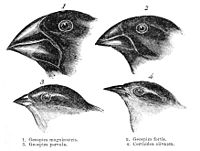
Depth dependent amino acid substitution matrices and their use in predicting deleterious mutations.
Sign Up to like & getrecommendations! Published in 2017 at "Progress in biophysics and molecular biology"
DOI: 10.1016/j.pbiomolbio.2017.02.004
Abstract: The 20 naturally occurring amino acids have different environmental preferences of where they are likely to occur in protein structures. Environments in a protein can be classified by their proximity to solvent by the residue… read more here.
Keywords: dependent amino; substitution matrices; deleterious mutations; substitution ... See more keywords

Mistranslation can enhance fitness through purging of deleterious mutations
Sign Up to like & getrecommendations! Published in 2017 at "Nature Communications"
DOI: 10.1038/ncomms15410
Abstract: Phenotypic mutations are amino acid changes caused by mistranslation. How phenotypic mutations affect the adaptive evolution of new protein functions is unknown. Here we evolve the antibiotic resistance protein TEM-1 towards resistance on the antibiotic… read more here.
Keywords: deleterious mutations; adaptive evolution; mistranslation; mistranslation enhance ... See more keywords

GroEL/S Overexpression Helps to Purge Deleterious Mutations and Reduce Genetic Diversity during Adaptive Protein Evolution
Sign Up to like & getrecommendations! Published in 2022 at "Molecular Biology and Evolution"
DOI: 10.1093/molbev/msac047
Abstract: Abstract Chaperones are proteins that help other proteins fold. They also affect the adaptive evolution of their client proteins by buffering the effect of deleterious mutations and increasing the genetic diversity of evolving proteins. We… read more here.
Keywords: deleterious mutations; helps purge; genetic diversity; purge deleterious ... See more keywords

Impact of supplementation on deleterious mutation distribution in an exploited salmonid
Sign Up to like & getrecommendations! Published in 2018 at "Evolutionary Applications"
DOI: 10.1111/eva.12660
Abstract: Deleterious mutations have important implications for the evolutionary trajectories of populations. While several studies recently investigated the dynamics of deleterious mutations in wild populations, no study has yet explored the fate of deleterious mutations in… read more here.
Keywords: supplementation; deleterious mutations; impact supplementation; supplementation deleterious ... See more keywords

Genetic load has potential in large populations but is realized in small inbred populations
Sign Up to like & getrecommendations! Published in 2021 at "Evolutionary Applications"
DOI: 10.1111/eva.13216
Abstract: Populations with higher genetic diversity and larger effective sizes have greater evolutionary capacity (i.e., adaptive potential) to respond to ecological stressors. We are interested in how the variation captured in protein‐coding genes fluctuates relative to… read more here.
Keywords: diversity; deleterious mutations; populations realized; load ... See more keywords

No evidence for accumulation of deleterious mutations and fitness degradation in clonal fish hybrids: Abandoning sex without regrets
Sign Up to like & getrecommendations! Published in 2020 at "Molecular Ecology"
DOI: 10.1111/mec.15539
Abstract: Despite its inherent costs, sexual reproduction is ubiquitous in nature, and the mechanisms to protect it from a competitive displacement by asexuality remain unclear. Popular mutation‐based explanations, like the Muller's ratchet and the Kondrashov's hatchet,… read more here.
Keywords: degradation; accumulation; evidence; deleterious mutations ... See more keywords

From high masked to high realized genetic load in inbred Scandinavian wolves
Sign Up to like & getrecommendations! Published in 2022 at "Molecular Ecology"
DOI: 10.1111/mec.16802
Abstract: When new mutations arise at functional sites they are more likely to impair than improve fitness. If not removed by purifying selection, such deleterious mutations will generate a genetic load that can have negative fitness… read more here.
Keywords: genetic load; deleterious mutations; inbred scandinavian; high masked ... See more keywords

Compliance with NCCN screening and chemoprevention recommendations among carriers of deleterious mutations in the adenomatous polyposis coli gene.
Sign Up to like & getrecommendations! Published in 2018 at "Journal of Clinical Oncology"
DOI: 10.1200/jco.2018.36.4_suppl.571
Abstract: 571Background: Deleterious mutations in adenomatous polyposis coli gene (APC) lead to familial adenomatous polyposis [FAP] and attenuated FAP (aFAP) syndromes associated with hereditary colorectal cancer (CRC) and extra-colonic neoplasms. Reports suggest only two-third of such… read more here.
Keywords: mutations adenomatous; polyposis coli; deleterious mutations; gene ... See more keywords

The Impact of Recessive Deleterious Variation on Signals of Adaptive Introgression in Human Populations
Sign Up to like & getrecommendations! Published in 2020 at "Genetics"
DOI: 10.1534/genetics.120.303081
Abstract: Admixture with archaic hominins has altered the landscape of genomic variation in modern human populations. Several gene regions have been identified previously as candidates of adaptive introgression (AI) that facilitated human adaptation to specific environments.… read more here.
Keywords: human populations; deleterious variants; variation; recessive deleterious ... See more keywords

A Pipeline for Classifying Deleterious Coding Mutations in Agricultural Plants
Sign Up to like & getrecommendations! Published in 2018 at "Frontiers in Plant Science"
DOI: 10.3389/fpls.2018.01734
Abstract: The impact of deleterious variation on both plant fitness and crop productivity is not completely understood and is a hot topic of debates. The deleterious mutations in plants have been solely predicted using sequence conservation… read more here.
Keywords: deleterious coding; pipeline classifying; classifying deleterious; deleterious mutations ... See more keywords

Utilizing evolutionary conservation to detect deleterious mutations and improve genomic prediction in cassava
Sign Up to like & getrecommendations! Published in 2022 at "Frontiers in Plant Science"
DOI: 10.3389/fpls.2022.1041925
Abstract: Cassava (Manihot esculenta) is an annual root crop which provides the major source of calories for over half a billion people around the world. Since its domestication ∼10,000 years ago, cassava has been largely clonally… read more here.
Keywords: evolutionary conservation; genomic prediction; deleterious mutations; prediction ... See more keywords